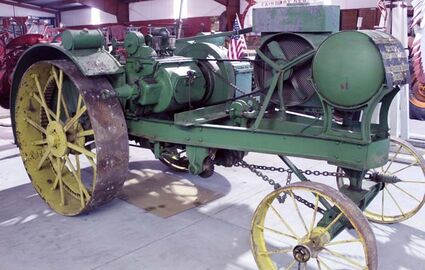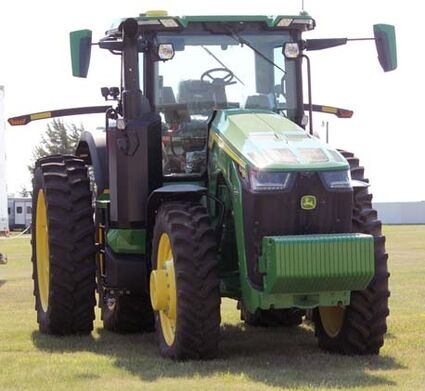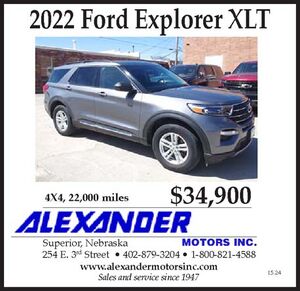Jewell County Threshing Bee-John Deere
July 15, 2021

The 1918 Waterloo Boy tractor was the first produced under the ownership of Deere and Company. The Aurand family used the tractor on their Jewell County farm. Deere bought the company after its efforts to develop a tractor of its own fell short. Deere purchases the Waterloo Boy Company in 1918.
Deere was widely credited with inventing the steel plow, a design which revolutionized American farming in the 19th century. The plow solved the problem presented by wooden or cast-iron mold boards and cast or wrought iron plow shares.
Early plows were unsuitable for use on the thick sticky soil of the Midwest. After the plow initially broke the soil, the soil would cling to the plow. This required the farmer to stop every few feet to clean the soil from the plow blade.
Deere was born in 1804 in Rutland, Vermont. His father was lost at sea when Deere was four years of age. He was raised by his mother. His formal schooling was brief. He began an apprenticeship in blacksmithing at the age of 17. He learned his craft well. He had a reputation for innovation and quality workmanship.
A financial panic in 1836 devastated the New England economy. Deere, along with many of his fellow Vermonters, moved west to Illinois. Deere landed in a community called Grand Detour, named because the Rock River makes an odd detour around the town. The town was founded by Leonard Andrus who used the honorific title, Major, in 1836. Andrus established a store as well as a sawmill and grist mill.
Deere set up his forge in Grand Detour. His services were in demand throughout the area. It was here that Deere is credited with using polished steel on the plow to solve the scouring problem. He once polished needles and pitch fork tines by running them through sand. He applied the same principle to the plow. The debate over the invention centers around Deere's relationship with Andrus. Credit for the first steel mortarboard plow goes to John Lane, a blacksmith from Lockport, Ill. Lane cut a steel plow blade into strips, welded them together, and hammered the blade into a curved shape. Lane never patented his invention. He manufactured less than 500 plows before his death in 1857.
Deere and Andrus went into business together. Some sources credit Andrus with the invention of the plow while others give the credit to Deere. The first plow was sold in 1837. It was the sole example sold the first year. Four were manufactured and sold in 1838. A second forge was added in 1839 and production numbers increased. In 1844, 400 plows left the forge. A new factory was constructed. It was called the L. Andrus Plough Manufactory. Steam power replaced power produced by horses. The partner in the enterprise was Deere. Deere grew dissatisfied with the marketing and financial practices of Andrus. Deere bought out his partner.
Deere relocated his manufacturing company to Moline, Ill., located on the Mississippi River. The town boasted excellent railroad connections. This factor would speed the distribution of his products throughout the country. The Mississippi River provided the power to operate the manufacturing plant at Moline. River boats, and later, the railroads, brought the raw materials needed to produce the plows. Deere's plows earned a stellar reputation among farmers and his business continued to grow.
Andrus continued to manufacture plows in Grand Detour. After his death in 1867, the firm was moved to Dixon, Ill. It was renamed the Grand Detour Plow Company. It was purchased by the J. I. Case Company in 1919.
Grand Detour faded into the past as the railroads by passed the town. Its industry was gone. Orson Welles stayed in the town for several summers as a young man as his father had purchased a hotel there. The town then became a resort destination. Today it is home to the John Deere Historic Site.
Deere was insistent on quality in his products. He said, "I will never put my name on a product that does not have in the best that is in me."
Deere's plow became known as "The plow that broke the plains." The company was incorporated as Deere and Company in 1868.
Deere was active in Moline's civic affairs. He was a president of the National Bank of Moline, a director of the Moline Free Public Library, as well as having served two terms as mayor of Moline. He was an ardent abolitionist and a long-time volunteer fire fighter.
Deere was married twice. He married Demarias Lamb in 1827. Demarias died in 1865. The couple had nine children, five of whom survived past the age of 20. He married Lucena Lamb, Demarias' sister, in 1867. She died in 1888.
Deere died on May 17, 1886. He is buried in the Deere family plot in the Riverside Cemetery in Moline. His epitaph reads. "He gave to the world the steel plow."
To avoid bankruptcy during a nationwide financial recession in 1857, the company was reorganized. Deere sold his interests in the company to his son-in-law, Christopher Webber, and his son, Charles, who took on the managerial duties formerly handled by John.
Charles introduced marketing centers. He employed independent retail dealers to expand the company's nationwide sales coverage.
In 1869, Deere and Company was awarded a silver medal and $10 for the "Best and Greatest Displays of Plows in Variety" at the 17th annual Illinois State Fair.
The company manufactured a small number of bicycles in the 1890s.
The early 20th century years through increased competition in the agricultural implement field from the newly formed International Harvester Company (formed from a merger of the McCormick Harvesting Machine Company, the Deering Harvester Company, The Milwaukee, Plano and Warder Company, the Bushnell Company and the Giessner Company), forced the company to expand the offerings in its implement business.
Deere would come to be defined as much by the production of gasoline tractors as it had been by steel plows.
Charles Deere died in 1907. He was replaced by Deere and Company vice-president William Butterworth. Butterworth was Charles Deere's son-in-law. He oversaw the expansion into the tractor business.
The company began to produce its own line of tractors with the Dain All-Wheel Drive being the most successful.
The company changed direction when it purchased the Waterloo Gasoline Traction Engine Company in 1918. The company manufactured the popular Waterloo Boy at Waterloo, Iowa. Deere sold the tractors under the Waterloo Boy name until 1923 when it introduced the Model D. Deere continues to manufacture a large number of tractors in Waterloo including the 7R, 8R and 9R series.
One notable difference between Deere and its competitors in the tractor industry was Deere's use of the two-cylinder engine. This engine design would carry over into the Deere designs. The two-cylinder engine would power Deere tractors in the United States until 1960 when four and six-cylinder engines were introduced.
The Waterloo Gasoline Traction Engine Company was organized in 1893. It was the Waterloo Company which pioneered the use of the two-cylinder engine. Deere acquired the company and continued with the two-cylinder layout. When production of the Waterloo Boy ended, some 30,000 units had been built and sold.
Design work on the John Deere Model D began in 1921. The model was introduced in 1925. It burned kerosene.
Customers requested a smaller tractor. The company designed and built the Model C which was introduced in 1927. The C model was replaced by the GP in 1928. The GP is thought to be the first tractor built with a power lift, mechanically operated, six-spline power take off unit. It was also offered in an orchard and wide-tread version. This model featured the steering column above the engine hood. This improved the operators vision as well as a narrow hood and fuel tank.
The Model A was a distillate burning tractor which lowered fuel costs. Rubber tires were used, rather than steel, which allowed for higher operating speed and increased efficiency. More pulling power was available through the same transmission. The operator enjoyed a more comfortable ride, The tractor could now be used to transport products off the farm.
The Model B was a smaller edition. The Model G was a larger model. The Model H was a smaller tractor introduced in 1938.
In 1936, The Henry Dreyfuss organization (famous for streamlining the New York Central Railroad steam locomotives) was hired to style the Deere tractors. The A and B lines were the first to sport the new styling. The Model D emerged with the new styling in 1940. Electric lights and starters became available. The hydraulic power lift allowed for the use of tractor mounted implements. The A and B models also featured an electric wiring option using an engine powered generator. The battery was located under the hood.
Tests showed the tractive power available was much higher on the same models equipped with rubber tires rather than steel wheels.
World War ll triggered a pause in commercial tractor production. The only model produced was the A.
During the war, Charles Deere Wiman, a great-grandson of John Deere was president of the company. He accepted a commission as colonel in the United States Army. He returned to work at the company in late 1944. During the war he directed the farm machinery and equipment division of the War Production Board.
Deere and Company manufactured military tractors. They produced transmissions for the M3 tank. The company also manufactured aircraft parts, ammunition and mobile laundry unIts.
With the conclusion of hostilities, Deere turned to the present and future. New models of the A, B, G lines were introduced as well as a new M line.
The A, B and G models underwent major changes. The battery location was moved under the seat support to provide improved cooling. Engine power as increased. The seat now had a back support and was cushioned. Lights and a starter were standard equipment. Four and six-speed transmissions were now available. An improved muffler design lowered noise emissions.
Returning veterans informed the company they were looking for noise reduction and personal comfort improvements. Travel speeds were increased with improved transmissions and power upgrades.
The Model R made its debut in August, 1948. A crankshaft issue caused the introduction to be delayed from 1947. The R model was diesel powered and the highest horsepower tractor produced by Deere up to this point in time.
Some operators claimed the tractor was underpowered when it pulled implements. Tractor stability was emerging as a major issue with an increasing number of tractor overturns. Increasing the weight on the front end of the tractor helped. The trend to rubber tires and away from crawler treads also helped, Production of the A, B and M models ceased in August, 1951. When production stopped, there had been more than 327,000 A models built. The B series checked out with more than 318,000 units produced while the M model had more than 49,000 examples built. The 40, 50 and 60 models were the replacement.
The G model ceased production in 1952 with more than 63,00 examples built. The D model went into the history books in March, 1954 with more than 161,000 copies produced. These were replaced by the model 70.
Tractors introduced in 1952, the 50, 60 and 70 series, utilized either tractor fuel (distillate), gasoline, liquid propane (lp) or diesel.
The R model was replaced with the Model 60 in August, 1955.
Farmers were demanding higher draw speeds. Minor tweaks were made to increase efficiency and power on the existing models.
The Model 730 was the final production two-cylinder model for the company. The diesel powered machine was restyled from the 720 but mechanically was little changed. The tractor was fuel efficient but was showing its age as competitors introduced a new generation of tractors.
The last of the 730 model rolled off the production line on March 1, 1961. This was not the end of the 730 though.
Deere had constructed a plant in Rosario, Argentina. The tooling was shipped from Waterloo. Improvements on the Argentine 730 included power steering. More than 20,000 examples of the 730 were produced in Argentina before production ceased in 1970 marking the end of the Deere and Company two-cylinder engine saga.
For Deere, the early tractor years were fiscally difficult. In 1924, the company reported a loss of $3.44 million on tractor sales. It would take nine years before the tractor division turned a profit. The company has not been faced with losses in the tractor division since.
On August 30, 1960, John Deere dealers from around the globe were hosted in Dallas, Texas. It was Deere Day and the company introduced its new generation of power to the agricultural community. The event featured the debut of modern four and six-cylinder tractors.
The new line of tractors, the 1010, 2010, 3010 and 4010, They were more powerful than previous designs. They were more comfortable to operate, had conveniently located controls, better visibility as well as improved seat suspension. They were easier to service. The 4010 was rated at 80 horsepower but tested out at 84. It was one of the most powerful two-wheel drive farm tractors available at the time.
The "10" series tractors also featured advanced hydraulics and a high horsepower to weight ratio. The 4010 model sold more than 58,000 units from 1960 to 1963. The model 4020 was introduced in 1964. This was the year Deere became the top manufacturer of farm equipment in the United States in 1973, the 4030, 4230, 4430 and 4630 models were introduced. They featured redesigned sheet metal. An optional completely integrated operators cab was offered. The insulated cab featured a roll-over protective structure and was equipped with heat and air conditioning. Speakers for an optional radio or 8-track tape player were also offered Later adaptations of the models features an optional hydraulic seat as well as an upgraded transmission.
In 1983, Deere introduced the 4050, 4250, 4450, 4650 and 4850 models. These offered a 15-speed transmission as well as optional mechanical front-wheel drive.
In 1962, the company employed 35,00 workers, 9,000 of whom were in Illinois. The company had six plants located in Moline as well as a seventh in Hoopeston, Illinois.
Deere is known for more than tractors. The company introduced its first self-propelled combine in 1947. It was designated the model 55. Smaller models, 40 and 45, as sell as the larger model 95 and the model 105, the largest followed in the ensuing years. Deere introduced the attachable corn head in the mid 1950s. This allowed corn growers to cut, shell and clean corn in one operation.
Deere introduced a new line of combines in the 1969. These were equipped with Quik-Tatch header mounting capability as standard equipment. This allowed producers to easily switch heads when they harvested different crops. These had larger capacity and better cabs.
The introduction of the "maximizer" line in 1989, including the 9400, 9500 and 9600, featured center mounted cabs, a rear mounted engine and more comfort in the cab.
The 50 series Maximizer line was presented in 1999. These offered a streamlined appearance, PTO shaft-style hookups. Larger models were available as rotary machines. International Harvester introduced rotary combines in the 1970s but Deere was slow to follow their lead. They introduced the single tine separation system in 1999 which uses less horsepower and improves material handling.
Deere and Company continues to thrive. The company employs more than 67,000 people around the globe. They have facilities in France, Argentina, India, Germany. Mexico, Brazil, The Netherlands and Finland.

Other than having wheels, the modern John Deere tractor shows no resemblance to the original Waterloo Boy. Modern tractors feature enclosed cabs with GPS, air conditioning and elaborate communication and entertainment equipment. They are capable of using many implements.
The company is developing autonomous operating systems utilizing machine learning.
Besides agricultural equipment, the company manufactures a range of forestry machinery including skidders, feller bunchers and log loaders.
The company has a large presence in the construction equipment business. It manufactures excavators, wheeled and tracked loaders, skid- steers and graders.
The John Deere logo of a leaping deer has been used by the company since the 1860s. It has undergone minor changes since that time. The company uses a distinctive green paint, also known as the most expensive shade of green paint, along with a yellow border.
The company slogan, "Nothing runs like a Deere" is a tribute to the vision and business acumen of one John Deere who saw a problem and provide a solution. The company, with many generations of the Deere family having been instrumental in its success, moves into the future with the same vision of change and adaptability.















Reader Comments(0)